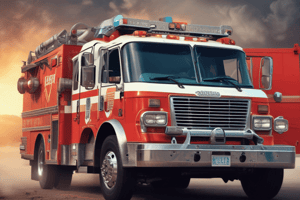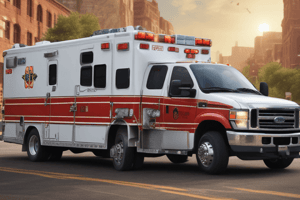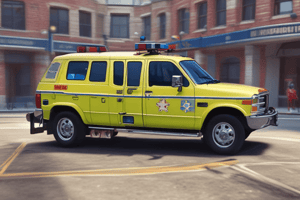Podcast
Questions and Answers
What is a key step to take when approaching an alternative powered vehicle involved in an incident?
What is a key step to take when approaching an alternative powered vehicle involved in an incident?
- Starting to extricate the passengers immediately
- Making sure the ignition is on
- Looking for specific markings on the vehicle (correct)
- Touching the vehicle to check for any damage
What should responders avoid when dealing with alternative powered vehicles?
What should responders avoid when dealing with alternative powered vehicles?
- Contact with the vehicle's occupants
- Contact with passengers
- Contact with the vehicle's tires
- Contact with leaking fluids (correct)
Who should be called to assist with a HazMat incident involving an alternative powered vehicle?
Who should be called to assist with a HazMat incident involving an alternative powered vehicle?
- HazMat team (correct)
- Tow truck operator
- Emergency medical services
- Fire department
What is an important consideration when performing vehicle extrication?
What is an important consideration when performing vehicle extrication?
What type of tool is a Halligan tool?
What type of tool is a Halligan tool?
What is a key resource that responders can consult during a HazMat incident?
What is a key resource that responders can consult during a HazMat incident?
What is the primary goal when accessing a patient during a rescue operation?
What is the primary goal when accessing a patient during a rescue operation?
What type of tools are required for complex access during a rescue operation?
What type of tools are required for complex access during a rescue operation?
What is the purpose of disentanglement during a rescue operation?
What is the purpose of disentanglement during a rescue operation?
What is the term for preparing a patient for movement as a unit during a rescue operation?
What is the term for preparing a patient for movement as a unit during a rescue operation?
What is the purpose of labeling left and right sides of a vehicle during a rescue operation?
What is the purpose of labeling left and right sides of a vehicle during a rescue operation?
What type of support do roof posts or pillars provide to a vehicle?
What type of support do roof posts or pillars provide to a vehicle?
What is the purpose of disconnecting the batteries and high voltage systems when rescuing from an alternative powered vehicle?
What is the purpose of disconnecting the batteries and high voltage systems when rescuing from an alternative powered vehicle?
What is an example of an alternative powered vehicle?
What is an example of an alternative powered vehicle?
Flashcards are hidden until you start studying
Study Notes
Patient Access and Rescue
- Simple access to patients requires hand tools like sledgehammers, window punches, glass saws, Halligan, or pry bars.
- Complex access requires special tools like reciprocating saws, hydraulic rims, spreaders, and cutters.
- Consistent communication with patients during rescue is crucial to avoid further injury.
- Gain access to patients depending on incident type and patient injuries, and begin emergency medical care as soon as possible.
- A team member should stay with the patient to direct rescuers during disentanglement, performing a primary assessment and crucial interventions before disentanglement.
Disentanglement and Packaging
- Disentanglement involves freeing a patient from the area or object they are trapped in.
- Prepare for removal by maintaining control of life-threatening conditions, addressing wounds, and stabilizing suspected fractures and spinal injuries.
- Expedite removal if the patient is deteriorating rapidly or if additional hazards are present.
- Packaging involves preparing the patient for movement as a unit, using backboards or similar devices, and carrying by hand or using a basket stretcher.
Vehicle Anatomy and Structural Components
- Use standardized terminology when referring to specific vehicle parts.
- Label left and right sides of the vehicle, not relative to the rescuer.
- Roof posts or pillars provide vertical support and are typically labeled as A, B, C, and so on.
- The engine compartment and passenger compartment are separated by the bulkhead and firewall.
Alternative Powered Vehicles
- Alternative powered vehicles can be electric, liquid petroleum, compressed natural gas, ethanol, biodiesel, or hybrid.
- Electric vehicles are powered by hydrogen fuel cells, all-electric batteries, or a combination of hybrid gasoline and electric power.
- Rescue personnel can secure the electrical system by disconnecting the batteries and high voltage systems.
- Be aware of hazards like leakage of chemicals from damaged battery packs, toxic gels, liquid, or gases.
Safety Concerns and Hazmat Procedures
- Alternative powered vehicles present a range of safety concerns and special challenges.
- Follow tips for managing alternative power vehicle hazards, such as looking for specific markings, ensuring ignition is off, and stabilizing the vehicle.
- Be aware of toxic vapors, gases, or fumes, even if no fire is present, and avoid contact with leaking fluids.
- Determine if the high voltage battery pack has been disabled and the 12-volt source removed.
- Call for a HazMat team and set up a safety zone around the perimeter if necessary.
Vehicle Extrication and Hazmat Incidents
- Vehicle extrication may require specialized teams to manage Hazmat incidents.
- Be aware of additional hazards from the vehicles involved, including fire hazards, electrical hazards, fuel sources, and liquid runoff.
- Follow proper size-up and evaluation processes, and consult the ERG to identify pertinent data.
- Trained responders can assist operations and technician-trained responders by gathering information, sealing off the perimeter, and consulting the ERG.
Tools for Access
- H tools for access include striking tools, leverage, prying or spreading tools, cutting tools, lifting, pushing, and pulling tools.
- Examples of striking and leverage tools include hammers, axes, pry bars, and Halligan tools.
- Examples of cutting tools include saws, reciprocating saws, and hydraulic cutters.
Patient Access and Rescue
- Simple access to patients requires hand tools such as sledgehammers, window punches, glass saws, Halligan, or pry bars.
- Complex access requires special tools like reciprocating saws, hydraulic rims, spreaders, and cutters.
- Consistent communication with patients during rescue is crucial to avoid further injury.
- Access to patients should be gained depending on incident type and patient injuries, and emergency medical care should begin as soon as possible.
- A team member should stay with the patient to direct rescuers during disentanglement, performing a primary assessment and crucial interventions before disentanglement.
Disentanglement and Packaging
- Disentanglement involves freeing a patient from the area or object they are trapped in.
- Prepare for removal by maintaining control of life-threatening conditions, addressing wounds, and stabilizing suspected fractures and spinal injuries.
- Expedite removal if the patient is deteriorating rapidly or if additional hazards are present.
- Packaging involves preparing the patient for movement as a unit, using backboards or similar devices, and carrying by hand or using a basket stretcher.
Vehicle Anatomy and Structural Components
- Use standardized terminology when referring to specific vehicle parts.
- Label left and right sides of the vehicle, not relative to the rescuer.
- Roof posts or pillars provide vertical support and are typically labeled as A, B, C, and so on.
- The engine compartment and passenger compartment are separated by the bulkhead and firewall.
Alternative Powered Vehicles
- Alternative powered vehicles can be electric, liquid petroleum, compressed natural gas, ethanol, biodiesel, or hybrid.
- Electric vehicles are powered by hydrogen fuel cells, all-electric batteries, or a combination of hybrid gasoline and electric power.
- Rescue personnel can secure the electrical system by disconnecting the batteries and high voltage systems.
- Be aware of hazards like leakage of chemicals from damaged battery packs, toxic gels, liquid, or gases.
Safety Concerns and Hazmat Procedures
- Alternative powered vehicles present a range of safety concerns and special challenges.
- Follow tips for managing alternative power vehicle hazards, such as looking for specific markings, ensuring ignition is off, and stabilizing the vehicle.
- Be aware of toxic vapors, gases, or fumes, even if no fire is present, and avoid contact with leaking fluids.
- Determine if the high voltage battery pack has been disabled and the 12-volt source removed.
- Call for a HazMat team and set up a safety zone around the perimeter if necessary.
Vehicle Extrication and Hazmat Incidents
- Vehicle extrication may require specialized teams to manage Hazmat incidents.
- Be aware of additional hazards from the vehicles involved, including fire hazards, electrical hazards, fuel sources, and liquid runoff.
- Follow proper size-up and evaluation processes, and consult the ERG to identify pertinent data.
- Trained responders can assist operations and technician-trained responders by gathering information, sealing off the perimeter, and consulting the ERG.
Tools for Access
- H tools for access include striking tools, leverage, prying or spreading tools, cutting tools, lifting, pushing, and pulling tools.
- Examples of striking and leverage tools include hammers, axes, pry bars, and Halligan tools.
- Examples of cutting tools include saws, reciprocating saws, and hydraulic cutters.
Studying That Suits You
Use AI to generate personalized quizzes and flashcards to suit your learning preferences.




